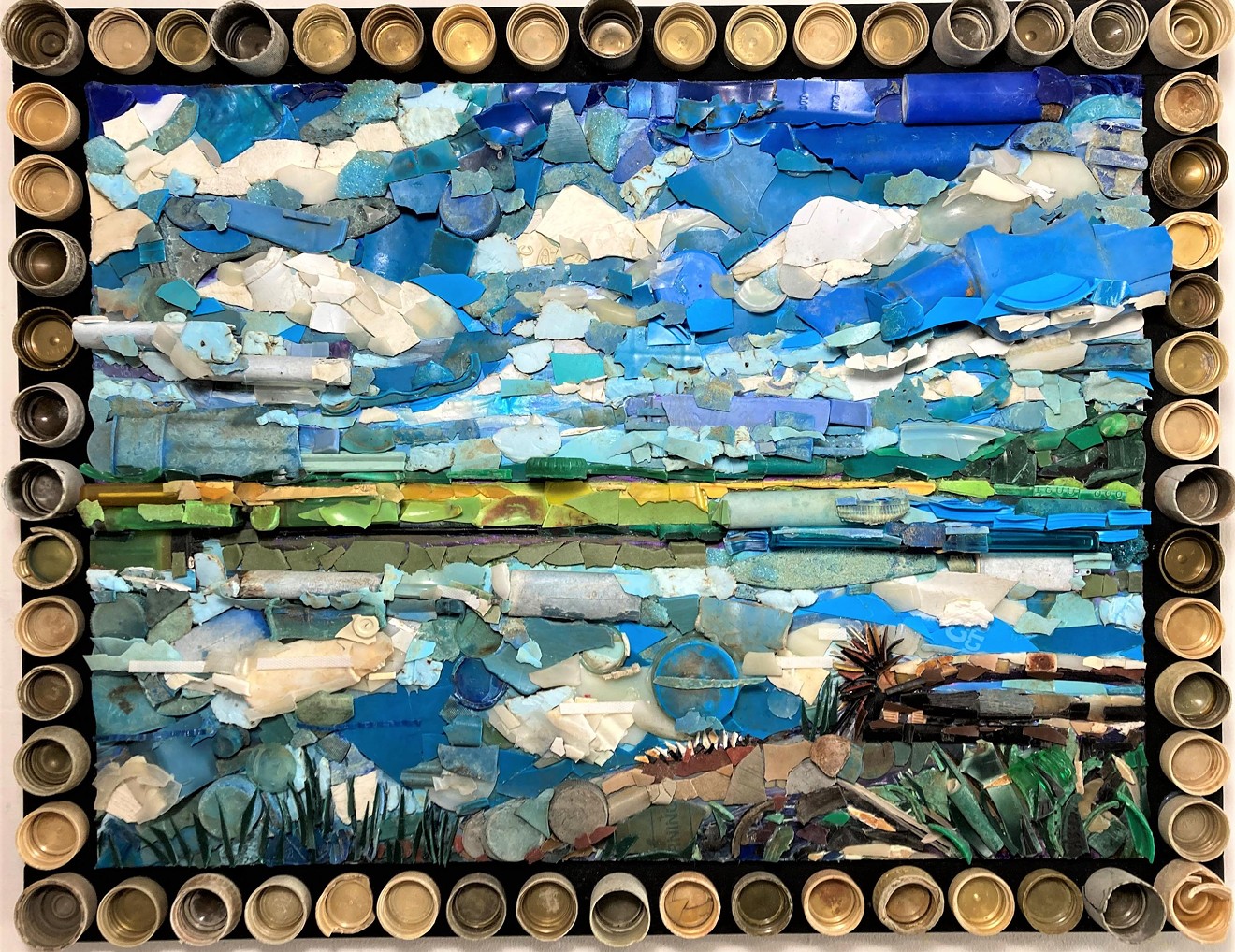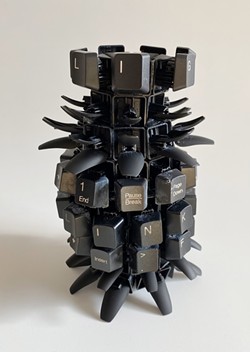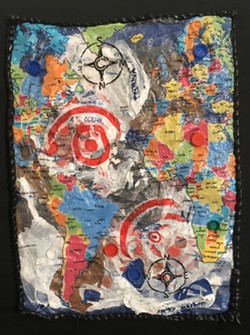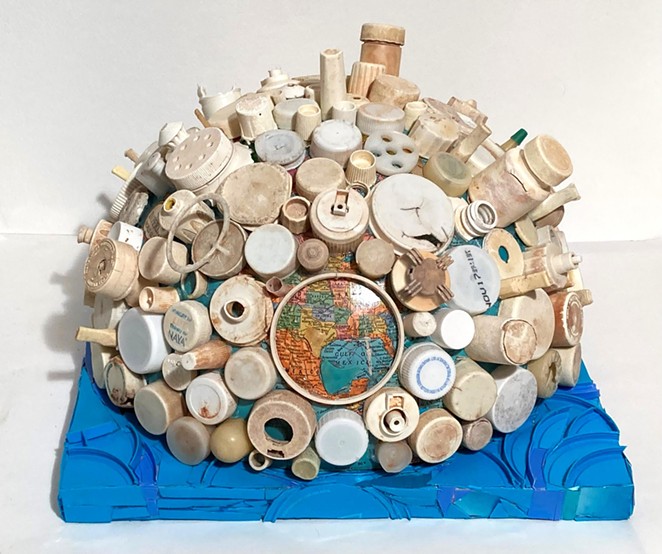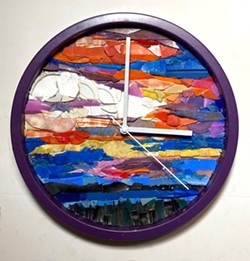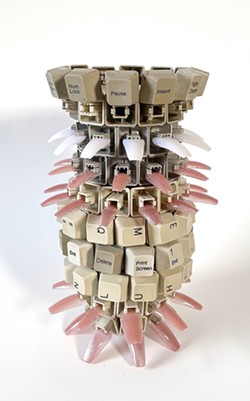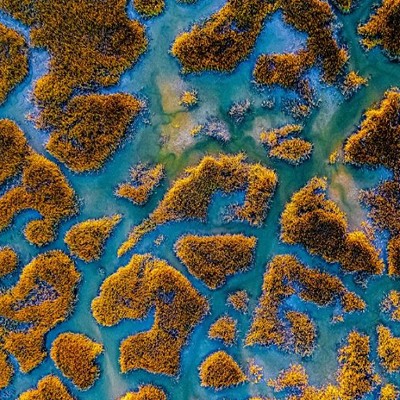Diligently, quietly, and consistently, husband and wife duo Harry DeLorme and Rachel Green have had a sustainable, green art practice for over three decades.
DeLorme graduated from UGA with an MFA in Studio Art, Drawing & Painting in 1985 and for the past 35 years has been employed by Telfair Museums where he serves as senior curator and director of education. He met his future spouse in the same MFA program, and since 1990 she has served as professor of art, fiber arts, printmaking, & foundations in the Betty Foy Sanders Department of Art at Georgia Southern University’s Armstrong campus.
Green, who grew up in Tennessee, says she fell in love with our beautiful coastline when she moved to Savannah after marrying DeLorme. “Even back then, we were very concerned about the destruction of the natural environment, plastic pollution, and habitat loss,” she says. “We started making work about that as far back as 1989, and gradually transitioned into using sustainable materials.”
Green continues, “I teach an environmental art class as part of the Sustainability minor in the Environmental Studies program.” Teaching students how to use sustainable materials, she has led them in such community projects as creating a mural at the Ogeechee Canal Museum & Nature Center and working on the City of Savannah Storm Drain art project, designed to remind us of our connection to our rivers and ocean.
Her own artwork incorporates old technologies from the past, such as obsolete cell phones and discarded keyboards. “People have handled these things and have memories of them, and it becomes a way to draw people in.” A recent sculpture entitled “Insert Light” is composed of black keycaps from cast off keyboards and black acrylic nails. At just 6.5 inches high, the basket-shaped piece with its spiky, hard surface resembles a hand grenade and is, perhaps, a dark commentary on the ticking timebomb of environmental destruction.
“I also use fibers,” Green says. “But Instead of using cloth and things that are comfy, I use plastic because that’s more indicative of what our environment is now - almost every surface is plastic. I use plastic Target bags, old shower curtains, garbage bags, and bottle caps.” We discuss her 24” by 30” quilted “Plastic Atlantic” which references the plastic gyres in the ocean – garbage patches of debris and microplastics that form by rotating ocean currents and resemble whirlpools as they suck more rubbish in. (There are five gyres in the ocean. One in the Indian Ocean, two in the Atlantic, and two in the Pacific. The most famous is the Great Pacific Garbage Patch – a floating vortex of debris that spans over 600,000 square miles.)
Both Green and DeLorme collect ocean plastic and use it in their work. DeLorme has used found objects relevant to environmental concerns for years. “I painted on found objects or incorporated strange materials for many years, painting on metal, on vinyl, on velvet, whatever,” he says. “In the 90’s and early 2000’s I was making fake real estate signs for fictional developments which were really about deforestation. Of course, that’s come back with a vengeance now with so much land being taken over by massive, logistics warehouses.” He adds wryly, “At least put a green roof on them, or solar panels, or something!"
“We’ve done projects and installations in Chicago, New York, North Carolina, and other places over the years,” DeLorme continues, “but I really started doing the plastics stuff in about 2012.” We look at one of his “Plastic Landscapes” where carefully curated pieces of colored plastic have been arranged to make a disturbingly attractive marsh scene framed by found shotgun shells. “I don’t do many of these as they are extremely time consuming.” Most of the materials were washed up from the Savannah River onto the McQueen Island Trail (the former railroad track that runs parallel to Highway 80 between Bull River and Fort Pulaski).
The artist says he recently started taking found materials and turning them into more functional items, such as wall clocks. And he is branching out into more sculptural pieces such as the strangely alluring “Plastic Planet,” a half globe covered in found bottle and container caps that transforms into something akin to a bristling creature or sea anemone. DeLorme tells me, “We were involved with Green Peace back when there was a chapter here. Now, we’re more involved in birding groups. We belong to Ogeechee Audubon and the Georgia Ornithological Society. Rachel’s a huge birder. I just curated the show about birds that’s at the Jepson currently. So, that’s a big passion right now and we’re still trying to figure out how to incorporate that into our work.”
Both artists work out of their home, each using a spare bedroom as their studio. Green says, “Harry has a studio full of plastic bits, and I have a studio full of old electronic parts.” DeLorme has picked up plastics from hikes, bike rides, and birding trips to Tybee, the Outer Banks, Ossabaw, and other coastal spots. “Originally I was bringing home backpacks full of stuff, but I realized I don’t have room for all this! I’ve got more plastic than I could possibly use.” His collection trips can be exciting – recently he disturbed a rattlesnake off the McQueen’s Island Trail. And they can be impactful – just the shear volume of “stuff” that’s discarded is sad, as his memory of discovering a dead turtle in a cache of plastic debris.
Neither spouse has much of an online presence. “We’re not great self-promoters,” DeLorme laughs. While he has some pieces for sale on the Arts Southeast website, he says, “We’re not in this to sell, so much as to promote the message. Despite their lack of social media presence, the couple still manages to regularly show their work. Locally, they have had a joint exhibition at Sulfur Studios and in the City of Savannah’s former SPACE Gallery, are often in local group shows, and were included in last month’s curated UN-TRASHED, an Art from Detritus show at NYC’s Veridian Artists gallery.
DeLorme sums up their practice by saying “We want people to think about what they actually need, whether you’re an artist making art or simply buying stuff. What do you really need and what are you doing with it?” As the statement from their recent New York show reads, “We must realize our environment is at stake if we continue to merely discard packaging and broken or undesired objects in our possession. We must begin to un-trash, reuse, and up-cycle all that we possibly can.”

